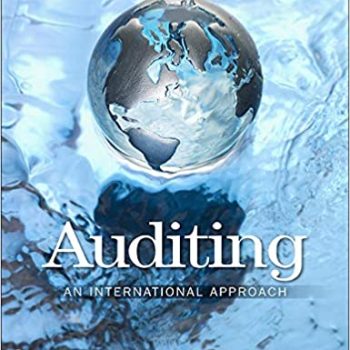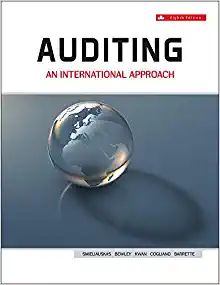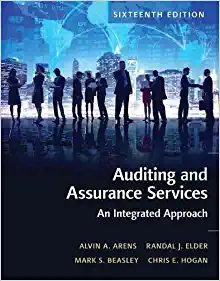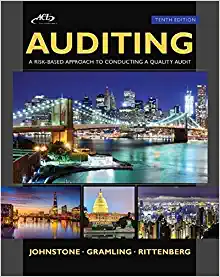Solution Manual For Auditing An International Approach 7th Edition By Smieliauskas
CHAPTER 1: Introduction to Auditing
SOLUTIONS FOR REVIEW CHECKPOINTS
ESSENTIALS
1-1. In this example of a three-party accountability structure, the owner is the ‘third party’, the hired manager is the ‘first party’ and the auditor is the ‘second party’. The owner is looking out for his/her own longer-term economic interests, but has to rely on the actions and information provided by the hired manager, who may have shorter term concerns (like his/her own compensation and job prospects) and thus act self-interestedly.
The owner is accountable for financing the business and treating the manager fairly, particularly in terms of compensating his/her efforts and successes appropriately. The manager is accountable for giving reliable and fair reports of the business profit performance to the owner. Give the potential conflicts between the interests of the first and third parties, there is information risk – the risk that the financial statement information will not be a full and fair representation of the transactions and events that really occurred, and will not be reliable for economic decisions that the owner may base upon it. The auditor is accountable for objectively verifying the fairness and reliability of the information and providing an independent opinion on how well the information reflects the underlying realities of the entity’s operations. The auditor’s opinion can benefit both the first and third parties – the owner directly by lowering information risk, and the manager indirectly because if the owner has more basis to trust the manager not to act against the owner’s interests the owner will be more willing to share the profits with the manager (this is referred to as lowering “agency costs,” which are charged by the owner/principal and incurred by the manager/agent if the owner does not trust the manager). For the auditor’s opinion to have value in giving the owner some comfort (i.e., “assurance”) that the manager’s information can be relied on, the auditor must have no personal interest in either side and be able remain objective.
1-2. The concept of reasonable assurance describes a mental attitude that the auditor gains from the conclusions drawn from audit examination findings. Based on the examination, if the auditor comes to believe the financial statements are reliable and fair to the interests of third party users, this belief forms the basis of the opinion the auditor will communicate to financial statement users in the Auditor’s Report. An ‘audit opinion’ provides a high level of assurance to the user that the auditor believes that the information risk is low, and has evidence to support that belief.
TEXT
1-3 Auditors add credibility to financial information provided by the accountable party such as management (i.e. auditors make the financial or other information more likely to be true or representationally faithful). Other common ways of characterizing this property of audited numbers is that the numbers are more accurate, have higher assurance, or are more reliable. These relate to different dimension of truthfulness, as we discuss later in the text.
1–4 By obtaining more accurate or reliableinformation about the company, Aunt Zhang can obtain a more accurate valuation of the company. This more accurate valuation gives Aunt Zhang more confidence that she will get her money’s worth in the investment. The preceding assumes Aunt Zhang is risk averse—a common assumption about economic behavior.
1-5 Auditing is the verification of numbers provided by others. To attest means to lend credibility or to vouch for the truth or accuracy of the statements that one party makes to another. The attest function is a term often applied to the activities of independent PAs when acting as auditors of financial statements.
Since financial statements are prepared by managers of an entity who have authority and responsibility for financial success or failure, an outsider may be skeptical that the statements are objective, free from bias, fully informative, and free from material error–intentional or inadvertent. The audit opinion of an independent-PA auditor helps resolve those doubts because the auditor’s success depends upon his independent, objective, and competent assessment of the conformity of the financial statements with GAAP. The auditor’s role is to lend credibility to the statements, hence the outsider will likely seek his independent audit opinion.
1-6 Client: the company, board of directors, agency, or some other person or group who retains (hires) the auditor. Usually the party who pays the fee.
Auditee: the entity (e.g., business firm, hospital, city government) whose financial information is under audit.
Auditors: report to the client on the auditee’s financial or control information.
Three party accountability consists of the auditor, the accountable party ofthe auditee such as management of the auditee, and the users. Users include the client as defined above. Traditionally management hired the auditor sothat there was some confusion as to who was the true client. New corporategovernance concepts in part attempt to clarify this three party accountability.
1-7 Auditors gather evidence related to the assertions management makes in financial statements and render a report. Accountants record, classify, and summarize (report) a company’s assets, liabilities, capital, revenue, and expense in financial statements. Accountants produce the financial statements, auditors audit them.
1-8 The conditions of complexity, remoteness and consequences produce demands by outside users for financial reports. They cannot produce the reports for themselves because of these conditions. Company managers and accountant produce them.
1-9 Students can refer to the AAA and CAS 200 (CPA Canada) definitions in Chapter 1. Some instructors may want to extend the consideration of definitions to include the internal and governmental definitions.
In response to “what do auditors do,” students can refer to Exhibit 1-2 and respond in terms of: (1) obtain and evaluate evidence about assertions management makes about economic actions and events, (2) ascertains the degree of correspondence between the assertions and GAAP, and (3) gives an audit report (opinion).
Students can also respond more generally in terms of “lending credibility” to financial statements presented by management (attestation).
1-10 The essence of the risk reduction theory is that audits of financial statements reduce the information risk (probability of materially misleading statements) to users to a socially acceptable level.
These various users cannot take it upon themselves to determine whether financial reports are reliable, therefore low in the information risk scale. They do not have the expertise, resources, or time to enter thousands of companies








Reviews
There are no reviews yet.